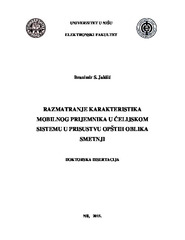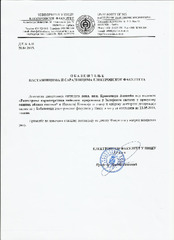Приказ основних података о дисертацији
Razmatranje karakteristika mobilnog prijemnika u ćelijskom sistemu u prisustvu opštih oblika smetnji
| dc.contributor.advisor | Stefanović, Mihajlo | |
| dc.contributor.other | Perić, Zoran | |
| dc.contributor.other | Milić, Dejan | |
| dc.contributor.other | Spalević, Petar | |
| dc.contributor.other | Panić, Stefan | |
| dc.creator | Jakšić, Branimir S. | |
| dc.date.accessioned | 2017-01-30T12:21:24Z | |
| dc.date.available | 2017-01-30T12:21:24Z | |
| dc.date.available | 2020-07-03T16:01:52Z | |
| dc.date.issued | 2015-10-13 | |
| dc.identifier.uri | https://nardus.mpn.gov.rs/handle/123456789/7442 | |
| dc.identifier.uri | http://eteze.ni.ac.rs/application/showtheses?thesesId=4454 | |
| dc.identifier.uri | https://fedorani.ni.ac.rs/fedora/get/o:1209/bdef:Content/download | |
| dc.identifier.uri | http://vbs.rs/scripts/cobiss?command=DISPLAY&base=70052&RID=533859734 | |
| dc.description.abstract | In this doctoral dissertation the characteristics of the mobile receiver in a cellular system have been considered. The influence of fast fading, slow fading and co-channel interference on the performance of the mobile receiver in a cellular system has been analyzed. The statistical characteristics of macrodiversity system with one macrodiversity and three microdiversity combiner is analyzed. Expressions for the statistical characteristics of the first and second order for a mobile receiver are obtained. On the basis of the calculated expression graphics are plotted, presenting statistical characteristics versus the system parameters important for the reception of signal. Based on the graphics the impact on the quality of signal transmission in cellular mobile systems was analyzed. Obtained results can be used in the proccess of simulation and design of real-world environments mobile telecommunication systems. In the second chapter an overview of the main drawbacks that occur in cellular mobile systems has been presented, as well as the distributions used to describe the useful signals, fading and interference models in mobile systems. Basic drawbacks in wireless telecommunication systems are Gaussian noise, slow fading, fast fading and various interferences. Main features of Gaussian noise are provided, as well as the characteristics of Rayleigh, Ricean, Nakagami-m, Weibul, Nakagami-q, α-μ, Gamma, k-μ, α-k-μ and η-μ distribution and the channel interferences. The third chapter reviews the makrodiversity system with macrodiversity SC (selection combining) receiver and two and three microdiversity SC receiver. At its inputs occurence of fast k-μ fading and slow Gamma fading have been observed. The level crossing rate and the cumulative probability of k-μ random variables, level crossing rate signals at the output of microdiversity SC receiver and level crossing rate of the signals at the output of macrodiversity system with two microdiversity SC receivers were calculated. The probability density of the signal at the output microdiversity SC receiver and the probability density of the signal at the output of macrodiversity system with three microdiversity SC receivers were also calculated. Obtained results are graphically presented: the level crossing rate of k-μ random variable depending on the different values of Ricean k factor, the cumulative probability of k-μ random variables for different values of Ricean kfactor and for the number of clusters μ, level crossing rate of the signals at the output of microdiversity receiver for different values of Ricean k factor and for the number of clusters μ, the level crossing rate of the signals at the output of macrodiversity system with two SC microdiversity receiver for different values of Ricean k factor, shadowing severity c and the number of clusters μ through which signal propagates. Finally, probability density signal at the output of macrodiversity system with three SC microdiversity receivers for different values of Ricean k factor, depth of shading channel c and number of clusters μ are graphically presented. In the fourth chapter macrodiversity system with macrodiversity SC (selection combining) receiver and three microdiversity MRC (maximum ratio combining) receiver has been discussed. At the inputs of the MRC microdiversity receivers occurence of independent k-μ fast fading and slow Gamma fading has been considered. For the signal at the output of the macrodiversity system were calculated: the probability density function, cumulative distribution function, characteristic function, moments, channel capacity and the ABER - Average Bit Error Probability over various modulation schemes. Based on the obtained expressions graphics are plotted and analized in the function of system parameters, i.e. probability density function of signals versus different values of the number of propagation clusters μ; the cumulative probability of the signal at the output of macrodiversity system versus different values of Ricean k factor and the number of propagation clusters μ; moments of the output signal from macrodiversity system versus the number of clusters, and ABER for Coherent Phase Shift Keying (CPSK), Coherent Frequency Shift Keying (CFSK), Differential Phase Shift Keying (DPSK) and Non-Coherent Frequency Shift Keying (NFSK). The fifth chapter is related to the macrodiversity system with macrodiversity SC receiver, two and three microdiversity the EGC (equal gain Combiner) receiver. Microdiversity EGC receivers have two inputs. At the inputs of the receiver an independent, identical k-μ fading is present. At the inputs of all of the three base stations long-term Gamma correlated fading is also present. The moments at the output of the macrodiversity system were calculated. Based on the graphic is analyzed the impact the correlation coefficient ρ, Ricean k factor, the number of clusters μ and shadowing severity, on the first moment, on the second moment and on the third moment and on the reception quality. In the sixth chapter statistical characteristics of the signal at the output of microdiversity SC receiver with two inputs in the presence of the useful signal and interference are considered. The cases when interference, described k-μ distribution, and useful signal described with Weibul, α-μ, α-k-μ and α-η-μ distribution are analyzed. For all cases probability density function and the cumulative distribution function of the signal at the output of the SC receiver were derived. Based on the graphics, the influence nonlinearity environment and the number of clusters through which extends signal on the transmission quality is analyzed. Also, the case when the k-μ distribution described and useful signal and interference is observed. Analytically are obtained and graphically presented expressions for the level crossing rate for the product and ratio of two k-μ random variables. Seventh chapter discusses the level crossing rate signal at the output of macrodiversity system with three SC microdiversity combiner and one macrodiversity SC combiner. At the inputs of the base station is present fast α-μ fading and slow Gamma fading. The obtained analytical results are presented graphically. Based on the graphics, the impacts of the number of clusters through which signal propagates, shadowing severity, correlation level and the non-linearity of propagation environment on the reception signal in a cellular system are analyzed. | en |
| dc.format | application/pdf | |
| dc.language | sr | |
| dc.publisher | Универзитет у Нишу, Електронски факултет | sr |
| dc.rights | openAccess | en |
| dc.rights.uri | https://creativecommons.org/licenses/by-nc-nd/4.0/ | |
| dc.source | Универзитет у Нишу | sr |
| dc.subject | makrodiverziti prijemnik | sr |
| dc.subject | macrodiversity receiver | en |
| dc.subject | mikrodiverziti prijemnik | sr |
| dc.subject | k-μ feding | sr |
| dc.subject | srednja verovatnoća greške po bitu | sr |
| dc.subject | kumulativna verovatnoća | sr |
| dc.subject | srednji broj osnih preseka | sr |
| dc.subject | momenti | sr |
| dc.subject | koeficijent korelacije | sr |
| dc.subject | Rajsov k faktor | sr |
| dc.subject | broj klastera | sr |
| dc.subject | microdiversity receiver | en |
| dc.subject | k-μ fading | en |
| dc.subject | average bit error probability | en |
| dc.subject | cumulative probability | en |
| dc.subject | level crossin rate | en |
| dc.subject | moments | en |
| dc.subject | correlation coefficient | en |
| dc.subject | Ricean k factor | en |
| dc.subject | number of clusters | en |
| dc.title | Razmatranje karakteristika mobilnog prijemnika u ćelijskom sistemu u prisustvu opštih oblika smetnji | sr |
| dc.type | doctoralThesis | en |
| dc.rights.license | BY-NC-ND | |
| dcterms.abstract | Стефановић, Михајло; Перић, Зоран; Милић, Дејан; Спалевић, Петар; Панић, Стефан; Јакшић, Бранимир С.; Разматрање карактеристика мобилног пријемника у ћелијском систему у присуству општих облика сметњи; Разматрање карактеристика мобилног пријемника у ћелијском систему у присуству општих облика сметњи; | |
| dc.identifier.fulltext | https://nardus.mpn.gov.rs/bitstream/id/52075/Disertacija7441.pdf | |
| dc.identifier.fulltext | https://nardus.mpn.gov.rs/bitstream/id/52076/Jaksic_Branimir_S.pdf | |
| dc.identifier.fulltext | http://nardus.mpn.gov.rs/bitstream/id/52075/Disertacija7441.pdf | |
| dc.identifier.fulltext | http://nardus.mpn.gov.rs/bitstream/id/52076/Jaksic_Branimir_S.pdf | |
| dc.identifier.rcub | https://hdl.handle.net/21.15107/rcub_nardus_7442 |



